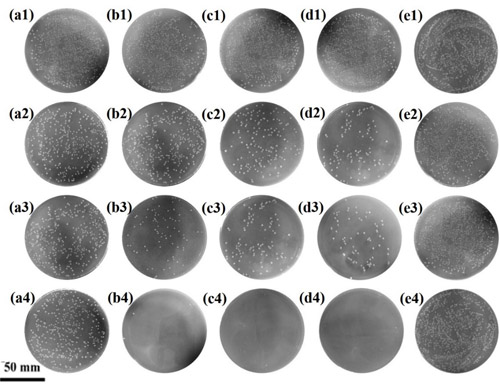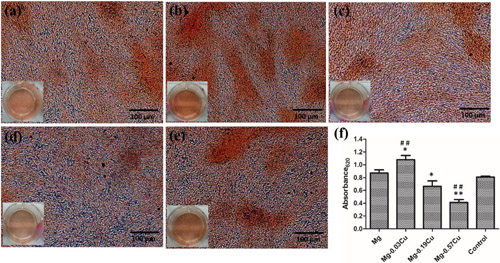Magnesium alloys are a new class of medical metal materials with great clinical application potentials, owing to their characteristics of good biocompatibility, matched mechanical properties with bones, and biodegradability in human body. In recent years, the biomaterials group led by Prof. Ke Yang from the Institute of Metal Research, Chinese Academy of Sciences (IMR,CAS), created a new concept of biofunctionalization for metal materials. The core of this idea is to offer medical metal materials some biofunctions besides their original excellent mechanical properties, which will certainly reach better medical effects. Based on this new concept, Ke Yang’s group recently developed a novel biodegradable Mg-Cu binary alloy with multi-biofunctions. Recent work conducted by Chen Liu, a Ph.D student supervised by Ke Yang, et al, indicates that by means of high alkalinity and continuous release of Mg and Cu ions produced during degradation of Mg-Cu alloy in biological environment, the novel biodegradable Mg-Cu alloy presents multi-biofunctions including antimicrobial, promoting osteogenesis and angiogenesis, while maintaining good bio-safety and mechanical supporting ability, which will have great value for clinical applications.
Copper (Cu) is an important trace element in human body, playing adjusting roles to the body's metabolism and the function of many kinds of enzymes. Cu can promote the hematopoietic function, adjust absorption and use of iron, maintain normal functions of bone, blood vessel, skin and endocrine, and promote collagen formations for bone, blood vessel and skin. A deficient Cu can affect the secretion system and immune function of human body, resulting in occurrence of some diseases such as anemia, thrombosis, coronary artery sclerosis, arthritis and osteoporosis. The strong antibacterial ability of Cu has been well known and used for a long time, which is only an approved solid material with inhibition of microbial awarded by the Environment Protection Agency (EPA) in USA. Cu can effectively and durably inhibit growth of pathogenic bacteria, possessing highly killing effect against different bacteria such as S. aureus, E. coli, E. aerogenes, C. albicans and P. aeruginosa.
Based on the degradability of magnesium (Mg) metals in biological environment and the multi-biofunctions of Cu, Ke Yang’s group develop a novel biodegradable Mg-Cu alloy with multi-biofunctions, and the related China Patent is applied. Relevant studies indicate that the Mg-Cu alloy could continuously release Mg ions and Cu ions, and the release rates are in the ranges human body can accept and not harmful to the biosafety. Tests on hemolysis and cytotoxicity indicate that the Mg-Cu alloy has good blood and cell compatibilities. Antibacterial test indicates that the Mg-Cu alloy has twofold antibacterial activities against S. aureus through high alkalinity and Cu ions release, presenting better antibacterial performance (Fig.1). Besides, the Mg-Cu alloy also possesses remarkable functions of promoting osteogenesis (Fig.2) and angiogenesis (Fig.3).
Development of novel multi-biofunctional biodegradable Mg-Cu alloy realizes integrity of structure/biomedical function of biodegradable magnesium alloy, which is beneficial to reduce the infection associated with implant material, make better medical effect for biodegradable magnesium alloy, give better choice for clinical doctors and patients, and strongly support wide applications for biodegradable magnesium alloys as well. The related research results are published online recently in Scientific Reports (Chen Liu, Xuekun Fu, Haobo Pan, Peng Wan, Lei Wang, Lili Tan, Kehong Wang, Ying Zhao, Ke Yang, Paul K. Chu. Biodegradable Mg-Cu alloys with enhanced osteogenesis, angiogenesis, and long-lasting antibacterial effects, 2016, DOI: 10.1038/srep27374).

Fig.1 S. aureus colonies after cultured with extracts of different materials for 0h (a1-e1), 6h(a2-e2), 24h (a3-e3) and 72h (a4-e4), (a) Mg; (b) M-0.03Cu alloy; (c) Mg-0.19Cu alloy; (d) Mg-0.57Cu alloy; (e) 304 stainless steel.

Fig.2 alizarin red staining of preosteoblast (MC3T3-E1) after co-cultured with extract of Mg-Cu alloy for 15 days, (a) Mg; (b) Mg-0.03Cu; (c) Mg-0.19Cu; (d) Mg-0.57Cu; (e) blank group; (f) quantitative analysis.

Fig.3 3D images of vascular ring structures after co-cultures of human umbilical vein endothelial cells (HUVECs) in colloid with extract of Mg-Cu alloy for 4, 8 and 16h.
Keywords: Biodegradable Magnesium Alloy, Biofunction, Cu Ions
Contact:
Prof. Ke Yang
Email: kyang@imr.ac.cn
Institute of Metal Research, Chinese Academy of Sciences, 72 Wenhua Road, Shenyang, Liaoning, 110016, China